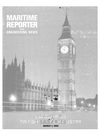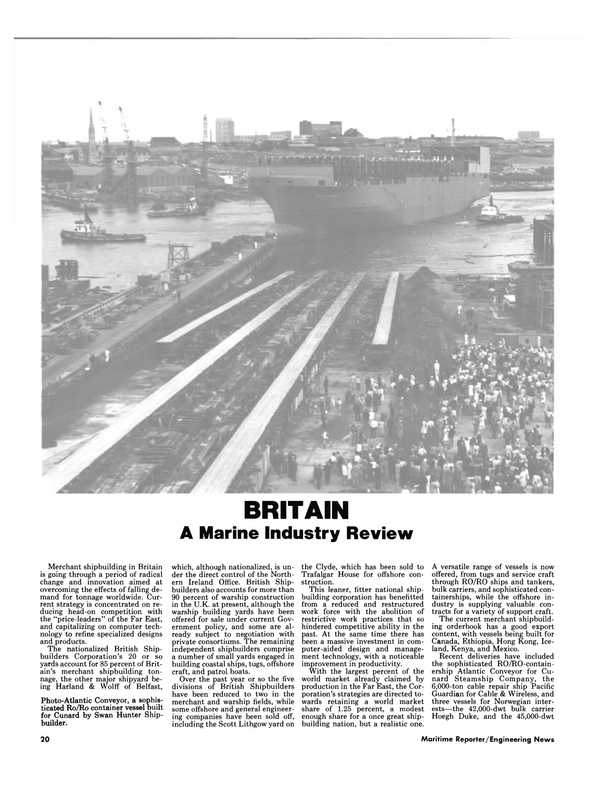
Radio Holland Introduces Expanded Marine Communications Line
Radio Holland USA, B.V., one of the nation's largest distributors of advanced communications and navigational equipment, recently had a "hands-on" private exhibition of their Total Shipboard Communications Center at the Houston headquarters complex. Attendees at the three day session included a wide range of technical and operational personnel from the shipping and marine electroncis industries. According to Sal Berte, general sales manager of Radio Holland, the program was planned to provide potential customers with an opportunity to see the most modern equipment live in a real-life environment.
Among the equipment on display was Radio Holland's new FCC type approved TR 4750 survival craft/ lifeboat radio. This ultracompact system transmits on the 500, 2182 and 8364 kHz international distress frequencies, and meets all current applicable SOLAS, ITU and FCC requirements for two-way communications.
For use on 500 and 8364 kHz, the TR 4750 incorporates an automatic switching and automatic keying device which transmits the radiotelegraph distress signal on both frequencies, as well as the DF dash on 8364 kHz. A built-in twotone generator provides automatic transmission of the radiotelephone alarm signal on 2182 kHz. The unit will operate either from an external 24 VDC battery or from the built-in hand-cranked generator.
Circle 20 on Reader Service Card As the exclusive distributor for Sailor radio equipment in the U.S., Radio Holland had virtually the entire product range available. Included was the new FCC type approved Program 1000/B 400W SSB radio system with fully automatic telex capability; the new FCC type approved 500 kHz main/reserve SOLAS radio station; the complete VHF radiotelephone line including the new ultracompact full duplex RT 2047 with scanning, dual watch and selective calling all in a package occupying less than one-half cubic foot, the well known multi-remote RT 146; plus Sailor's new CRY 2001 compact scrambler that permits up to 16.8 million possible code combinations for the ultimate in communications security.
This line of Sailor equipment is manufactured by S.P. Radio A/S of Aalborg, Denmark, in a modern factory capable of producing in excess of 20,000 sets annually. The company's product line has become known worldwide both for reliable operation and the distinctive green finish that provides a nylon finished, scratch-free surface that is highly resistant to salt water.
Circle 21 on Reader Service Card The Program 1000/B short wave communications system is able to meet all maritime communications needs in the frequency range from 1.6 to 27.5 MHz due to the unusual design flexibility. A variety of receivers, transmitters, exciters and power supplies can easily be mounted in the Sailor 19" rack to satisfy the communications requirements of every size vessel. In addition, the antenna coupler can be mounted directly at the foot of the antenna for maximum efficiency.
The system can also operate under full remote control to meet the requirements of an automated radiotelex station. In the ARQ mode, the system works through a single antenna and has switching speed sufficient for telex operation over a single simplex frequency.
One configuration of the Sailor Program 1000/B is the Nordic Maritex Terminal. Maritex is an automated radiotelex system for the exchange of ship-to-ship or ship-toland information. The central Maritex equipment is located at Gothenberg Radio and gives subscribers the ability to automatically transmit and receive telex messages 24 hours a day. The system is open to shipowners of all nations and complies with land mobile and diplomatic applications as well as marine.
Circle 22 on Reader Service Card At the other end of the communications spectrum, Radio Holland also featured Comsat Telesystems' new MCS 9100 compact, lightweight satellite communications terminal, integrated with the new Philips PACT 250 teleprinter that offers a large CRT display. Another product shown was the Telesystems "in-asuitcase" portable satellite communications terminal.
Circle 23 on Reader Service Card In the VHF radiotelephone range, Radio Holland offered two Sailor products. The first was the familiar RT 146, which is a full duplex synthesized set for all international maritime VHF channels. An unlimited number of full function control units may be used with the system.
The new RT 2047, as mentioned earlier, is a remarkably compact full duplex unit operating on all available VHF frequencies and including such standard features as dual watch, selective calling, scanning, and the ability to program as many as 60 private channels where permitted.
The new Sailor CRY 2001 compact scrambler was also available for demonstration. This unit provides up to 16.8 million possible code combinations via its use of both time and frequency division scrambling techniques. With the CRY 2001, full privacy is assured even with selective or group calling. It may be used with VHF, SSB, or ordinary telephones.
Circle 24 on Reader Service Card In navigation equipment, Radio Holland provided one of the first public demonstrations of the new NCD-39 electronic charting system from Odin Electronics, Inc. This unit is capable of storing navigation charts in digital computer memory, then displaying them at a scale of your choice on a bright 12" monochrome CRT display. It will interface with most popular loran or satnav receivers to provide position tracking information in real time.
The user may overlay a wide range of information and even personalize charts with wrecks, drilling rigs, shoals, etc. A password security system protects private chart data and an automatic chart stringing function supports long voyages.
Circle 25 on Reader Service Card The three day seminar was considered to be an outstanding success by all attendees.
Read Radio Holland Introduces Expanded Marine Communications Line in Pdf, Flash or Html5 edition of March 1985 Maritime Reporter
Other stories from March 1985 issue
Content
- New Partnership Formed To Operate Large Versatile Lift-Boat Fleet page: 4
- IMODCO Awarded Contract To Convert Egyptian Tanker page: 5
- MarAd Approves Sale Of Delta Steamship To United States Lines page: 5
- Moran And Watt Elected Vice Presidents At Moran Towing & Transportation page: 6
- Suehrstedt Appointed President Of Marine Consultants & Designers— Plude Named Vice President page: 6
- Third Aegis Cruiser 'Vincennes' Completes Initial Sea Trials page: 6
- Wittmeyer Succeeds Serrie As Operations Vice President At Penn Ship page: 6
- MSC Awards $41.7-Million Contract To Sea Mobility To Operate T-AGOS Ships page: 7
- Whitey Co. Offers Compact Ball Valves Rated To 2,200 PSI page: 7
- Two Vice Presidents And An Assistant Vice President Named AT J.J. Henry Co. page: 7
- Blue Streak-Gulf Island Operations Christens Giant Lift Boat page: 7
- Brinlee Named General Manager-Venezuela For Loffland Brothers page: 8
- Southwest Marine Will Operate Ship Repair Facility In Samoa page: 8
- Horner, Cass And Tullai Appointed Managers For Seaworthy Systems page: 8
- Foss Shipyard Appointed Authorized Workshop For Stork-Werkspoor Diesels page: 8
- Unitor Named Distributor Of K.E.W. Cleaning Machines page: 8
- THE FY 86 NAVY PROGRAMS page: 8
- Currence Named President Of Tidewater Marine page: 10
- Valmet Shipyard Begins Construction Of Birka Line Passenger Vessel page: 11
- EXPOSHIP LONDON 85 International Exhibition MONEY & SHIPS IN THE CITY International Conference page: 12
- Operate 365 Days a Year with Greater Efficiency, Safety and Profits page: 15
- Raytheon Introduces New Remote Display For Speed Log And Depth Sounder page: 16
- Bethlehem Yard Gets $25-Million Contract To Refit Barber Line Ships page: 16
- Promar Appointed U.S. Southeast Representative For Anritsu Radar Line page: 17
- Cummins Introduces First Of Its B And C Series Marine Models page: 17
- Valmet And Foster Wheeler Petroleum To Cooperate On Offshore Projects page: 18
- Port Engineers' Society Meeting Hears Paper On Fuel Oil Separators page: 18
- Piatt To Market Its Own Zinc Ribbon Anodes page: 18
- Radio Holland Introduces Expanded Marine Communications Line page: 18
- BRITAIN A Marine Industry Review page: 20
- DIESEL POWER SYSTEMS EQUIPMENT page: 20
- Bombardier/ALCO A New Force In Diesel Manufacturing page: 37
- Rolls-Royce Renames Holding Company For Canadian Operations page: 38
- Johnson Appointed Director Of Marketing For Bulkfleet Marine page: 38
- Catton, Fleming And Rogaski Promoted At Drew Ameroid Marine page: 38
- Free Actuator/Ball Valve Reference Book Offered By Pittsburgh Brass page: 38
- Bostik Offers New Material On Marine Grade Sealants page: 39
- Texas Instruments Introduces New Satplan® Software For Global Positioning System page: 40
- Massport Building New $4-Million Passenger Cruise Ship Terminal page: 40
- Field Appointed Vice President-Manufacturing For Fairbanks Morse page: 40
- Marinette Marine Awarded $7-Million Navy Contract For Two Additional TWRs page: 40
- Pilot Operated, Hot Gas Solenoid Valve Introduced By Valcor Engineering page: 40
- Monarch Introduces New Pistol Grip Portable Tachometer page: 40
- New Tug Company Formed To Serve Great Lakes Port And Harbor Areas page: 41
- Coast Guard Approves Radar Training Courses At Marine Simulation page: 41
- Cat's New Diagnostic Tools Improve Servicing page: 42
- Blohm + Voss Awarded $3.4-Million Contract To Renovate Cruise Ship page: 42
- Sigmaform Introduces GK-A60 Multi-Cable Transit System page: 42
- Signet Forms New Ocean Transportation Services Division page: 42
- S/S R&D Offers Brochure On Fuel Oil Emulsifier page: 43
- Sperry Gets $16.8-Million Government Contract For Shipboard Data System page: 43
- Giannotti Firm Awarded Mexican Navy Contract For Engineering Services page: 43
- Hoglund Named Senior Vice President For Dillingham Maritime page: 43
- Sperry Marine Systems Plans To Acquire Navidyne page: 44
- Executive Appointments Announced At HUD page: 44
- Herman Of Mobil Shipping Named Chairman Of AIMS—Lengyel Remains President page: 44
- New Book On Radar Published By Cornell Maritime Press page: 44
- Brown Named General Manager Of Uniroyal's Engineered Systems Unit page: 44
- TACH-IV Wide Range Non-Contact Tachometer Offered By Monarch page: 44
- Baldt Introduces New Rapid Release System page: 44
- Marine Jet Drives Offer Unique Advantages page: 45
- EPSCO Gets Navy Order For Navigation Plotters page: 45
- Sohn Named President Of Hyundai Mipo Dockyard page: 46
- New Brochure Details Harris HF Marine Radio Products page: 47
- Moran Expands Container Barge Service To Ports Of Philadelphia And Baltimore page: 50
- Hackney And Spath Appointed Vice Presidents At Beier Radio page: 50
- Henschel Dedicates New Combined Facility At New Location in Newburyport page: 50
- "Handy Size" Bulk Carrier Delivered By Mitsui Shipyard page: 58


